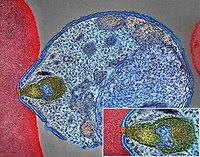
Photo from wikipedia
Background: Understanding the magnitude of human exposure to mosquito biting is fundamental to reduce pathogen transmission. Here we report on a study quantifying the levels of mosquitoes attacking humans throughout… Click to show full abstract
Background: Understanding the magnitude of human exposure to mosquito biting is fundamental to reduce pathogen transmission. Here we report on a study quantifying the levels of mosquitoes attacking humans throughout the night in a rural area of Southern Mozambique. Methods: Surveys were carried out in Massavasse village, southern Mozambique. The abundance and composition of host-seeking mosquito communities at night were assessed by human-landing catches (HLC) at one-hour intervals. Periods when people were located predominantly outdoors or indoors were used to estimate the amount of residents’ exposure to mosquito bites in either location, to explore the potential impact a bed net could have had in reducing biting by each vector species. Results: A total of 69,758 host-seeking female mosquitoes comprising 23 species in four genera were collected. The exposure to biting by virtually all vector species was consistently high outdoors, typically at early evening and morning, with exception of An. gambiae s.l which was likely of biting a person with nearly same intensity indoors and outdoors throughout the night. Bed nets use could have reduced biting by An. gambiae s.l (dominated by An. arabiensis), Ma. africana, Ma. uniformis, Cx. pipiens, Cx. antennatus, and Cx. poicilipes by 53%, 47%, 46%, 38%, 31%, and 28% respectively, compared to non-users. Conversely, a bed net user would have had little protection against An. pharoensis, An. ziemanni, An. tenebrosus, and Cx. tritaeniorhynchus biting exposures. Conclusions: This study showed that Massavasse residents were exposed to high levels of outdoor biting by malaria and arbovirus vectors that abound in the village. The findings help to identify entomological drivers of persistent malaria transmission in Mozambique and identify a wide range of arbovirus vectors nocturnally active in rural areas, many with outbreak potential. The study highlights the need for a surveillance system for monitoring arboviral diseases vectors in Mozambique.
Journal Title: Wellcome Open Research
Year Published: 2023
Link to full text (if available)
Share on Social Media: Sign Up to like & get
recommendations!